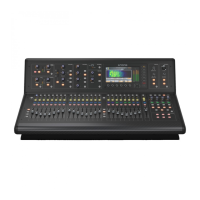
Do you have a question about the Midas M32 and is the answer not in the manual?
| Channels | 40 |
|---|---|
| Outputs | 16 x XLR |
| Faders | 25 |
| Sample Rate | 48 khz |
| Type | Digital |
| Talkback | 1 x XLR |
| A/D Resolution | 24-bit |
| Dynamic Processing | Yes |
| Control Surface | Yes |
| Effects | 8 stereo effects processors |
| EQ | 4-band |
| Display | 7" TFT |
| Connectivity | Ethernet, USB |
| Inputs - Other | 6 x Aux |
| Outputs - Main | 2 x XLR |
| Outputs - Other | 6 Aux, 2 FX |
| Data I/O | Ethernet, AES50 |
| USB | 1 x Type B |
| Computer Connectivity | USB, Ethernet |
| I/O Expansion Slots | 1 x Expansion Slot |
| MIDI I/O | In/Out |
| Word Clock | In/Out |
| Depth | 490 mm |
| Weight | 15 kg |
| USB Audio Interface | 32-in/32-out |
| Network Audio | AES50 |
| Dimensions | 760 x 168 x 490 mm |
| Inputs | 32 x XLR/TRS combo |
Advises on electrical shock prevention and proper handling of signals.
Guidance on grounding, warnings, and general handling of the equipment.
Details the controls for input channels, including layer selection and individual strip controls.
Describes controls for group/bus channels, including layer selection and individual strip controls.
Covers gain, LED display, frequency, 48V, phase, and low cut settings for preamps.
Controls the threshold level for the compressor.
Cycles through EQ modes and applies them to frequency ranges.
Selects the specific frequency centre point for EQ adjustment.
Describes the main display's graphical elements and user navigation.
Overview of selected input/output channel and adjustments not on top panel.
Displays level meters for various signal paths for level adjustment.
Allows signal patching from internal paths to physical input/output connectors.
Controls global functions like display, sample rates, user settings, and network config.
Displays general signal path for the selected input or output channel.
Connects external lamps and studio monitors.
Outputs audio to external equipment via XLR cables.
Connects audio sources via XLR cables.
Details processing, connectors, input/output characteristics, display, power, and physical specs.
Includes routine maintenance, cleaning, and equipment disposal guidelines.
Buttons to select group/bus channel layers (DCA, Bus 1-16, MTX/Main).
Describes common controls like SEL, SOLO, MUTE, and Fader for group/bus channels.
Adjusts the microphone preamplifier input gain.
Adjusts the output level for monitor outputs.
Adjusts the signal level through headphone jack sockets.
Connects a microphone via XLR cable, providing phantom power.
Adjusts the talkback volume.
Details settings for talkback paths, destination, and auto-dim function.
Offers adjustments for talkback paths, destinations, and auto-dim function.
Controls onboard oscillator settings for PA setup and signal testing.
Allows saving, recalling, and managing scenes and associated parameters.
Allows selective parameter and channel filter storage and recall.
Configures which parameters are not saved or switched with console scenes.
Assigns four rotary controls to parameters for instant access.
Activates layers of custom-assignable controls.
Creates a customizable virtual acoustic space, adding warmth and depth.
Simulates reverberation in medium-to large-sized halls for a lush quality.
Simulates the sound of vibrations on a plate for a bright-colored sound.
Details FCC compliance for Class A digital devices and potential interference.